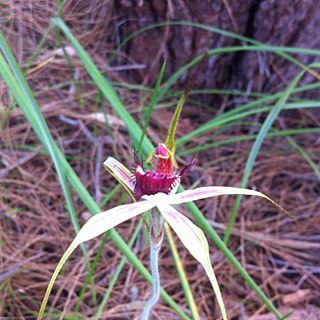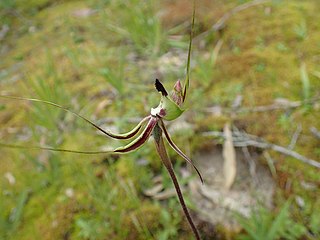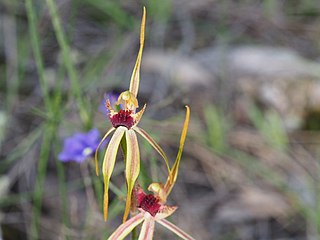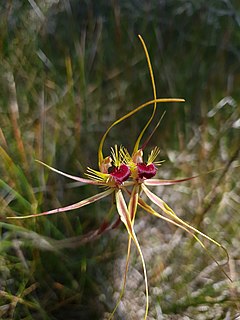Caladenia cristata, commonly known as the crested clown orchid or crested spider orchid is a species of orchid endemic to a small area in the south-west of Western Australia. It has a single hairy leaf and a greenish-yellow and red flower on an unusually tall spike, considering the small size of the flower. Since its discovery in 1923 and collections made in 1923 it was thought to be extinct, until rediscovered in 1986.

Caladenia doutchiae, commonly known as the purple-veined clown orchid or purple-veined spider orchid is a species of orchid endemic to the south-west of Western Australia. It has a single hairy leaf and usually only one greenish-yellow and red flower with short, downswept petals, and lateral sepals that are broad at the base then narrow to a glandular tip.

Caladenia ensata, commonly known as the stumpy spider orchid, is a species of orchid endemic to the south-west of Western Australia. It is a common orchid within its natural range and has a single, hairy leaf and up to three pale yellow and red flowers which have short but thick, fleshy glandular tips.

Caladenia excelsa, commonly known as the giant spider orchid, is a species of orchid endemic to a small area in the south-west of Western Australia. It is a rare species with a single, hairy leaf and up to three cream-coloured to greenish-cream flowers with long, drooping sepals and petals. It is one of the tallest spider orchids in Western Australia and, with Caladenia splendens, has the largest flowers of any Western Australian orchid.

Caladenia exilis subsp. exilis, commonly known as the salt lake spider orchid, is a plant in the orchid family Orchidaceae and is endemic to the south-west of Western Australia. It is a relatively common spider orchid with a single erect, hairy leaf and up to three white to greenish-cream flowers with a small white, red-striped labellum.

Caladenia exstans, commonly known as the pointing spider orchid, is a species of orchid endemic to a small area in the south-west of Western Australia. It has a single, hairy leaf and one or two green, yellow and red flowers with a labellum which does not curl downwards but "points" forward.
Caladenia graminifolia, commonly known as the grass-leafed spider orchid is a species of orchid endemic to the south-west of Western Australia. It has a single glabrous leaf and one or two short-lived, greenish-yellow and red flowers which have a narrow labellum with long teeth on its sides.
Caladenia graniticola, commonly known as the Pingaring spider orchid, is a species of orchid endemic to the south-west of Western Australia. It has a single, hairy leaf and one or two yellowish-green, red and white flowers which have a greenish-yellow and white labellum with a red tip. It was originally described as Caladenia hoffmanii subsp. graniticola but has a slightly different labellum and column.
Caladenia hoffmanii, commonly known as Hoffman's spider orchid is a species of orchid endemic to the south-west of Western Australia. It has a single, hairy leaf and one or two, greenish-yellow, red and white flowers which have a greenish-yellow labellum with a red tip. It is distinguished from the Pingaring spider orchid by small differences in the labellum and more northerly distribution.

Caladenia huegelii, commonly known as the grand spider orchid is a species of orchid endemic to the south-west of Western Australia. It has a single, hairy leaf and up to three relatively large red, green and cream-coloured flowers which have "split-hairs" on the sides of the labellum.

Caladenia infundibularis, commonly known as the funnel-web spider orchid is a species of orchid endemic to the south-west of Western Australia. It has a single hairy leaf and up to three greenish-yellow flowers which have a red-tipped labellum.

Caladenia attingens subsp. attingens, commonly known as the forest mantis orchid or sneezing spider orchid, is a species of orchid endemic to the south-west of Western Australia. It is a relatively common orchid with a single erect, hairy leaf and one or two green, yellow and red flowers. It is similar to the fringed mantis orchid but has smaller flowers and has a more southerly distribution.
Caladenia attingens subsp. effusa, commonly known as granite mantis orchid, is a subspecies of orchid endemic to the south-west of Western Australia. It has a single erect, hairy leaf and one or two green, yellow and red flowers. It differs from the other subspecies of Caladenia attingens in having smaller flowers with lateral sepals which are not upswept and a labellum which is less than 15 mm (0.6 in) wide.

Caladenia longiclavata, commonly known as the clubbed spider orchid is a species of plant in the orchid family, Orchidaceae and is endemic to the south-west of Western Australia. It is a widespread and common orchid with a single, hairy leaf and one or two greenish-yellow, white and red flowers and which grows in the area between Perth and Albany.

Caladenia macrostylis, commonly known as the leaping spider orchid, is a species of orchid endemic to the south-west of Western Australia. It has a single, hairy leaf and up to three distinctive pale greenish-yellow and red flowers with a cluster of deep purplish calli in the centre of its labellum.

Caladenia magniclavata, commonly known as the big clubbed spider orchid is a species of orchid endemic to the south-west of Western Australia. It has a single, hairy leaf and up to three pale yellow-green and red flowers with downswept, prominently clubbed sepals and petals.

Caladenia multiclavia, commonly known as the lazy spider orchid is a species of orchid, endemic to the south-west of Western Australia. It has a single, hairy leaf and one or two greenish-yellow, red and cream-coloured flowers resembling a reclining spider. Although it usually only has a single flower, it often grows in clumps of up to six plants.

Caladenia procera, commonly known as the Carbunup king spider orchid, is a species of orchid endemic to the south-west of Western Australia. It has a single erect, hairy leaf and up to four greenish-yellow and red flowers. It is one of the tallest and has amongst the largest flowers of the spider orchids.

Caladenia radiata, commonly known as the ray spider orchid, is a species of orchid endemic to the south-west of Western Australia. It has a single erect, hairy leaf and one or two green, yellow and red flowers. It flowers more profusely after fire and grows in swampy areas, sometimes flowering whilst in water.

Caladenia thinicola, commonly known as the Scott River spider orchid, is a species of orchid endemic to the south-west of Western Australia. It has a single erect, hairy leaf and up to four yellowish-green and red flowers with a fringe of long teeth on the sides of the labellum and thick brown, club-like glandular tips on the sepals.















